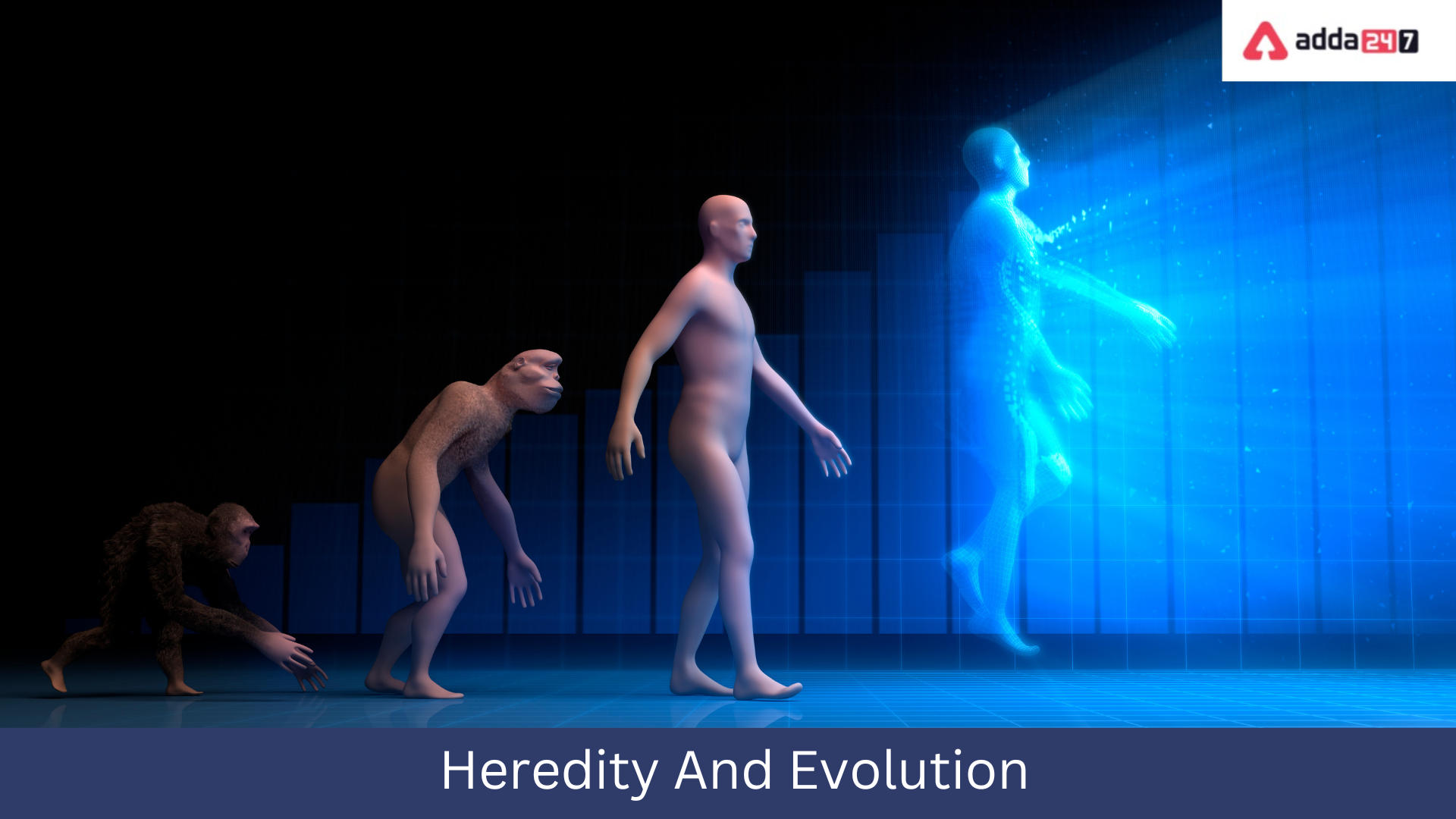Heredity and Evolution Class 10 Notes- Introduction
Heredity and Evolution Class 10 Notes are given here. Heredity refers to the passing of characteristics from one generation to the next. Evolution is defined as the gradual process by which a simple life form leads to the development of complex organisms over a period of time, spanning several generations.
Here in this chapter, we will learn about the mechanism by which variations are created, the rules of heredity determining their pattern of inheritance, and how the accumulation of these variations leads to evolution. Read full article for Heredity and Evolution Class 10 Notes.
Heredity and Evolution Class 10 Notes- Heredity
The transfer of traits from one generation to the next is termed heredity. Genes are the functional units of heredity that transfer characteristics from parents to offspring. Genes are short stretches of DNA that code for a specific protein or RNA.
Genetics is the branch of biology that deals with the study of genes, heredity and variations.
Sexual reproduction
- The mode of reproduction involves two individuals; one male and one female.
- They produce sex cells or gametes which fuse to form a new organism.
Genes
- Gene is the functional unit of heredity.
- Every gene controls one or several particular characteristic features in living organisms.
Heredity
The process by which the features of an organism are passed on from one generation to another is called heredity.
- The process is done by genes, which define the characters in the organism.
Mendel’s work
- Gregor Johann Mendel, known as the ‘Father of Genetics’, was an Austrian Monk who worked on pea plants to understand the concept of heredity.
- His work laid the foundation of modern genetics.
- He made three basic laws of inheritance – The Law of Dominance, The Law of Segregation and The Law of Independent Assortment.
Dominant traits
The traits that express themselves in an organism in every possible combination and can be seen are called Dominant traits.
- In Mendel’s experiment, we see that the tall trait in pea plants tends to express more than the short trait.
- Therefore, the tall trait of the plant is said to be dominant over the short trait.
Recessive traits
A trait which is not expressed in the presence of a dominant allele is known as recessive.
- So, recessive character/trait is present in an organism but cannot be seen if a dominant allele exists.
Monohybrid cross
- When only one character is considered while crossing two organisms, then such a cross is known as a monohybrid cross.
- The ratio of characters, arising out of this cross, at F2 generation is called the monohybrid ratio.
- E.g., If a tall plant (TT) is crossed with a dwarf plant (tt), we get 3 tall:1 short plant at the end of the F2 generation.
- So, 3:1 is a monohybrid ratio.
- Here, the height of the plant is considered at a time.
Below is the example of a monohybrid cross between a true-breeding pea plant with green pods (GG) and yellow pods (gg). Here, the green colour of the pod is the dominant trait. Hence, in the F1 generation, all plants contain green pea pods.
Dihybrid cross
- When two characters are considered while crossing two organisms, then such a cross is known as a dihybrid cross.
- The ratio of characters, arising out of this cross, at F2 generation is called the dihybrid ratio.
- E.g., If a plant with round and green pea is crossed with a plant with wrinkled and yellow pea,
- The first generation plants would all have round and green peas.
- On crossing the same for an F2 generation, we would observe four combinations of characters in the ratio of 9:3:3:1.
- Thus, 9:3:3:1 is the dihybrid ratio.
Heredity and Evolution Class 10 Notes- Inheritance
In Biology, inheritance pertains to the transfer of traits from one generation to another.
Laws of Mendel
Law of Dominance says that a gene has two contrasting alleles and one always expresses itself in the organism. It is called the dominant gene and it expresses in any possible combination.
Law of Segregation says that traits get segregated completely during the formation of gametes without any mixing of alleles.
Law of Independent Assortment says that the traits can segregate independently of different characters during gamete formation.
Heredity and Evolution Class 10 Notes- Sex determination
- The process of determining the sex of an individual, based on the composition of the genetic material is called sex determination.
- In different animals, the sex of an embryo is determined by different factors.
- In humans, sex determination happens on the basis of the presence or absence of the Y chromosome.
- XX is female and XY is male
- An ovum always contains an X chromosome.
- An ovum, upon fusion with the Y containing sperm, gives rise to a male child and upon fusion with the X containing sperm gives rise to a girl child.
Heredity and Evolution Class 10 Notes- Traits
Traits are characteristic features of an organism, manifested in a physical form that is visible or in a physiological aspect of the organism.
Heredity and Evolution Class 10 Notes- Acquired characters
- The traits that are acquired by an organism over the period of its lifetime are termed acquired characteristics.
- These characters that are not passed on to the DNA of germ cells do not get transferred to the next generation. E.g. loss of muscles and less weight due to starvation, loss of limb or tails due to injury, etc.
Heredity and Evolution Class 10 Notes-Inherited characters
- The traits that are inherited from the parents are called inherited characters.
- These traits always get transferred to the next generation but depending on the dominance or recessiveness they may or may not be expressed.
- Examples are height, skin colour and eye colour.
Heredity and Evolution Class 10 Notes-Variation
Variation is the measure of the difference between individuals of the same species. Offspring is not identical to parents, there exist some variations. Each individual in a population differs from the others. Recombination and mutation are the main causes of variations.
Sexually reproducing organisms show great variation among individuals of a species and the long-term accumulation of variations plays a significant role in evolution. The selection of variants by environmental factors is one of the driving factors of evolutionary processes.
Heredity and Evolution Class 10 Notes-Genetic variations
The differences in the DNA sequences among every organism leading to the diverse gene pool are called genetic variations. These differences lead to different/varied physical characters or biochemical pathways.
Heredity and Evolution Class 10 Notes- Natural selection
- It is the phenomenon by which a favourable trait in a population of a species is selected.
- Changing natural conditions exert equal pressure on all the existing species.
- The species/organisms which are better adapted to the changing conditions survive and reproduce i.e. selected by nature and species/organisms which cannot adapt perish i.e. rejected by nature.
Heredity and Evolution Class 10 Notes-Genetic drift
Natural selection can play an important role in deciding the traits that survive in a population. However, random fluctuations in gene variants are seen on many occasions. This phenomenon is known as genetic drift. Thus, genetic drift is a change in the frequency of an existing allele in a small population.
Genetic drift may cause a gene variant to disappear from the population and thus reduce genetic variation.
Heredity and Evolution Class 10 Notes-Speciation
It is the process of formation of a new species from existing ones due to several evolutionary forces like genetic drift, isolation of populations, natural selection, etc. Speciation leads to diversity in the ecosystem and the diversity and diversity lead to evolution.









 Try CUET College Predictor 2025 to Predi...
Try CUET College Predictor 2025 to Predi...
 CUET Result 2025 OUT (Today) @cuet.nta.n...
CUET Result 2025 OUT (Today) @cuet.nta.n...
 Why the Delay in CUET UG 2025 Results? C...
Why the Delay in CUET UG 2025 Results? C...









